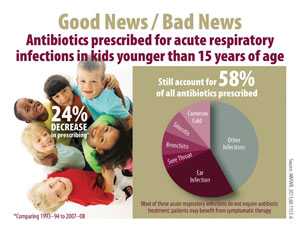Get Smart: Know When Antibiotics Work
Overview
CDC’s Get Smart: Know When Antibiotics Work (Get Smart) program is one of several efforts at CDC to help address the growing threat of antibiotic resistance. The Get Smart program concentrates its efforts on improving antibiotic prescribing in the outpatient setting (e.g., doctors’ offices, emergency rooms, retail clinics).
Program Rationale
Antibiotic resistance is one of our most serious health threats. CDC estimates that more than 2 million people are sickened every year in the United States with antibiotic-resistant infections, with at least 23,000 dying as a result. Antibiotic resistance has become a common clinical and community problem, and the association of resistance with the use of antibiotic drugs is well documented in both inpatient and outpatient settings.
CDC has outlined 4 core actions that fight the spread of antibiotic resistance:

- Preventing infections from occurring and preventing resistant bacteria from spreading
- Tracking resistant bacteria
- Improving the use of antibiotics
- Promoting the development of new antibiotics and new diagnostic tests for resistant bacteria
The Get Smart program focuses primarily on improving antibiotic prescribing and antibiotic use by healthcare providers and patients, respectively, in the community.
Program Objectives
The Get Smart program aims to reduce the rate of rise of antibiotic resistance by
- Promoting adherence to appropriate prescribing guidelines among healthcare providers
- Decreasing demand for antibiotics among both healthy adults and parents of young children
- Increasing adherence to prescribed antibiotics
Antibiotic Prescribing for Upper Respiratory Infections
Upper respiratory infections account for three quarters of all antibiotics prescribed by office-based physicians, and antibiotics are often used inappropriately (i.e., unnecessarily or the incorrect drug, dose, or duration). Even though prescribing rates have decreased, current data suggest that more than 10 million courses of antibiotics are prescribed each year for viral conditions that do not benefit from antibiotics.

The Get Smart program primarily targets 5 respiratory conditions that account for the majority of all office-based prescribing across all ages combined:
- Ear infection (otitis media)
- Sinus infection (sinusitis)
- Sore throat (pharyngitis)
- Chest cold (acute bronchitis)
- Common cold and runny nose
In addition to respiratory conditions, the Get Smart Program also provides resources for appropriate antibiotic prescribing for urinary tract infections and collaborates with CDC’s Influenza Division.
Target Audiences
The target audiences for the Get Smart program include patients and healthcare providers since knowledge, attitudes, and behaviors of both contribute to antibiotic prescribing and antibiotic use. Antibiotic prescribing is highest for young children; therefore special emphasis is placed on parents of young children and their healthcare providers. Adult patients and other primary care health providers (e.g., internal medicine, family practice, emergency department providers, and pharmacists) are additional target audiences.
Activities
Developing health education materials
CDC offers a suite of health education and behavioral change materials for both patients and healthcare providers to support appropriate antibiotic use. These materials include brochures, posters, fact sheets, academic detailing sheets, prescription adherence sheets, and symptomatic prescription pads, among other tools.
Order small quantities of select Get Smart materials for free.
Developing guidelines for appropriate antibiotic use
CDC collaborates with professional medical associations to develop diagnosis and treatment guidelines for upper respiratory infections. There are guidelines for both adult and pediatric patients.
Implementing a national media campaign
CDC developed a national media campaign to provide a coordinated message on appropriate antibiotic use and create a foundation for local efforts across the country. In collaboration with the Food and Drug Administration and using the tagline “Get Smart: Know When Antibiotics Work,” the campaign was launched on September 17, 2003, and messages have been disseminated through print, television, radio, and outdoor media.
View public service announcements and other media tools.
Providing assistance to local appropriate antibiotic use programs
CDC distributes federal funds to state and local health departments to develop, implement, and evaluate local programs to promote appropriate antibiotic use. View a map of currently funded sites. Technical assistance to support these funded sites includes:
- Identifying resources
- Sharing new scientific and educational information
- Facilitating networking and the formation of partnerships
- Conducting routine phone calls to track progress and identify program needs
Coordinating Get Smart About Antibiotics Week
The Get Smart program coordinates an annual observance, Get Smart About Antibiotics Week, to promote national, state, local and non-profit and for-profit activities to combat antibiotic resistance and highlight the importance of appropriate antibiotic use. The messages of the Get Smart programs are delivered through a variety of activities and resources every year, coinciding with European Antibiotic Awareness Day, Australia's Antibiotic Awareness Week and Canada's Antibiotic Awareness Week.
Measuring outpatient antibiotic use
To better understand trends in outpatient antibiotic prescribing and where interventions to improve prescribing are most needed, research is regularly conducted to analyze national and state prescribing data. Learn more about how we measure outpatient antibiotic prescribing.
Developing and testing Healthcare Effectiveness Data and Information Set (HEDIS®) performance measures
The National Committee on Quality Assurance, with support from CDC, developed two pediatric and two adult Healthcare Effectiveness Data and Information Set(HEDIS) measures. HEDIS is a performance measurement tool used by over 90% of the nation's health plans. Learn more about these HEDIS measures and how CDC is measuring outpatient antibiotic prescribing.
Developing curricula and continuing education
CDC supports development of medical school curricula and online continuing education courses for a variety of healthcare providers. View a list of these offerings.
Staff
The Get Smart program is headed by medical director, Dr. Lauri Hicks. Program staff develop, implement, and evaluate national activities, collaborate with both public and private partnerships to distribute program messages and education, conduct research on antibiotic use trends, and provide technical assistance to local programs in funded states.
Getting Involved
There are many partners that support the program in a variety of ways. Please visit our Partners page to learn more.
Contact Information
Please feel free to contact us at getsmart@cdc.gov.
- Page last reviewed: April 17, 2015
- Page last updated: April 17, 2015
- Content source:


 ShareCompartir
ShareCompartir